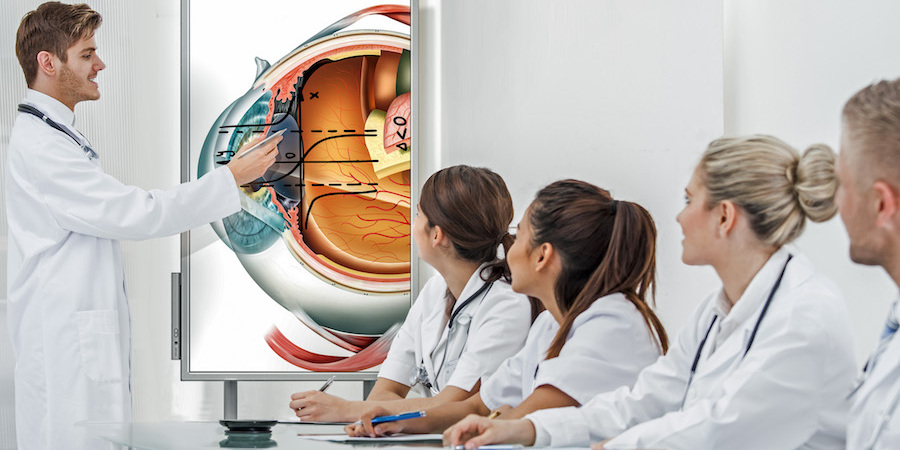Time is a precious commodity for caregivers. Any healthcare collaboration technology introduced to hospitals and clinics will likely see a warmer welcome — and broader use — if the technology saves time and requires minimal training.
Doctors, nurses and specialists often need to gather together on short notice to review findings, develop patient care plans and delegate tasks. Having to search for available meeting space or set up collaboration tech is a time-consuming interruption.
A new type of interactive display, the Samsung Flip 2 is more portable, more affordable and, most importantly, more user-friendly than conventional digital boards used in healthcare settings. The Flip 2’s intuitive design allows people to just walk right up to the board and start using it without a walkthrough. It shows the same promise in medical settings as in corporate and education environments.
Meanwhile, business collaboration tools designed for workspaces in flux are ideal for on-the-go caregivers, who may prefer to team up in an impromptu huddle space rather than a large, schedule-driven meeting room.
The interactive whiteboard is the new flipchart
Medicine is complicated and ever evolving, so doctors and nurses have a constant need to explain conditions and treatment plans to patients and their caregivers. Before smart boards, the only real education tools available in patient rooms were notepads, flipcharts and small portable whiteboards. In recent years, tablets have served as digital solution for patient care, but these small displays aren’t so well suited to the show-and-tell nature of group discussions.
Reimagine healthcare facility design — brilliantly
Discover how digital displays can empower caregivers, engage patients, and elevate health brands. Download Now
Samsung introduced a modern take on paper flipcharts with the Flip 2, a fully interactive whiteboard display that can be be brought right to the patient’s bedside, or wherever treatment plans are being discussed. With a form factor akin to flipchart easels, the Flip 2 is light and portable enough — on wheels — to move around hospital wings and even different floors.
The Flip 2 can be used just like a paper chart, allowing caregivers to quickly draw out diagrams, illustrating a patient’s upcoming procedure step by step. As many as four people can work on a Flip display at the same time, selecting unique markup colors and adjusting the weight (the line thickness) of their pen. Notes, charts and images from the Flip can all be annotated and saved, or shared with others.
Sharing information on the go
In hospitals and other busy healthcare environments, everyone on staff needs to stay up to date with the latest information to keep operations flowing smoothly. However, nurses, doctors and other team members are constantly on the move, and they’re rarely in the same place at the same time. If a nurse has a question about a patient, they have to stop what they’re doing, track down the patient’s doctor, who may be with another patient, which leads to longer wait times and frustrating breaks in communication.
This is where interactive displays can make a world of difference. Outside a patient’s room, for example, the Flip 2 can display the patient’s dietary restrictions, allergies or safety protocols that people need to take before to entering the room — all at a glance. These displays may also indicate if a patient has been temporarily moved to another department of the hospital. Everyone on the care team is always up to speed, leading to higher levels of productivity and improved collaboration among hospital staff.
When it comes to sharing information on the go, clarity is the name of the game. Samsung’s 4K displays and Ultra HD signage provide virtually flawless visual quality. Even if a doctor or nurse is just walking by a patient’s room, they can take a quick glance at a small digital display, like the QBR-T Series 13-inch, and get all the information they need in crisp detail. The QMR-T Series offers particularly bright and responsive interactive screens, which allow staff to navigate and view on-screen information with added ease.
Many ways to share
Instead of trying to explain a patient’s treatment plan only in words, a caregiver can use a nearby display to show the patient images or even videos. All the caregiver needs to do is connect their computer to the patient room’s digital signage or a Flip 2 board, either via standard HDMI or using screen mirroring via Wireless Display (WiDi). The steps of a patient’s care plan can be drawn out and listed on Flip pages, which are easily and securely saved to the cloud and shared. If the patient’s family member wants a copy of the care plan, it can be emailed to them directly from the Flip.
The displays are network-ready and connected by Wi-Fi or an Ethernet cable, so users can open any files stored and available on their network. Caregivers can pull up lab results and medical imaging, or share photos and testimonials of successful procedural outcomes to soothe the worries of patients and their families. Interactive whiteboards and patient room digital signage are changing the traditional doctor-patient dynamic — enabling active, visual collaboration that’s more engaging for patients and families, and more convenient for their providers.
Huddling up
From discovery to treatment to recovery, healthcare processes necessitate frequent, active collaboration. Care providers need to communicate among their teams, sharing different viewpoints and experiences.
There are times when quick discussions are necessary to help a patient as soon as possible, and the right people need to brainstorm together at a moment’s notice.
Corporate environments are increasingly using open office plans and encouraging agile, team-based solutions, leading to the rise of huddle spaces that support impromptu, unstructured meetings with easy, intuitive collaboration tools. These huddle spaces are particularly valuable for medical specialists scattered across a hospital campus — or around the globe. When face-to-face meetings aren’t feasible, care teams can quickly arrange a virtual patient case conference. Patients and their families can also consult with specialists remotely before making major healthcare decisions.
The need for spontaneous collaboration has led to the development of products such as huddle space solutions that, like the Flip 2, are designed to enable easier, more productive meetings. Samsung and HARMAN partnered to create four huddle room solutions, from basic videoconferencing all the way up to enterprise solutions with ultra-high-definition (UHD) displays, wide-angle HD cameras, touch overlays and smart devices for content sharing. All of these solutions are designed for a quick setup and intuitive use, in a compact form factor to suit space-limited healthcare facilities.
Research has found that for every hour that physicians spend face-to-face with patients, they spend almost two hours on data entry and clerical work. Digital technology solutions can cut down on paperwork and improve the quality time that providers spend with patients and their colleagues. But this technology isn’t really a solution unless it’s efficient and features an intuitive user interface. Fortunately, a new generation of collaboration technology, like the Flip 2 interactive whiteboard and patient room digital signage, is solving all those problems.
Learn more about digital signage in the healthcare setting, including collaborative technologies, with this free white paper.









